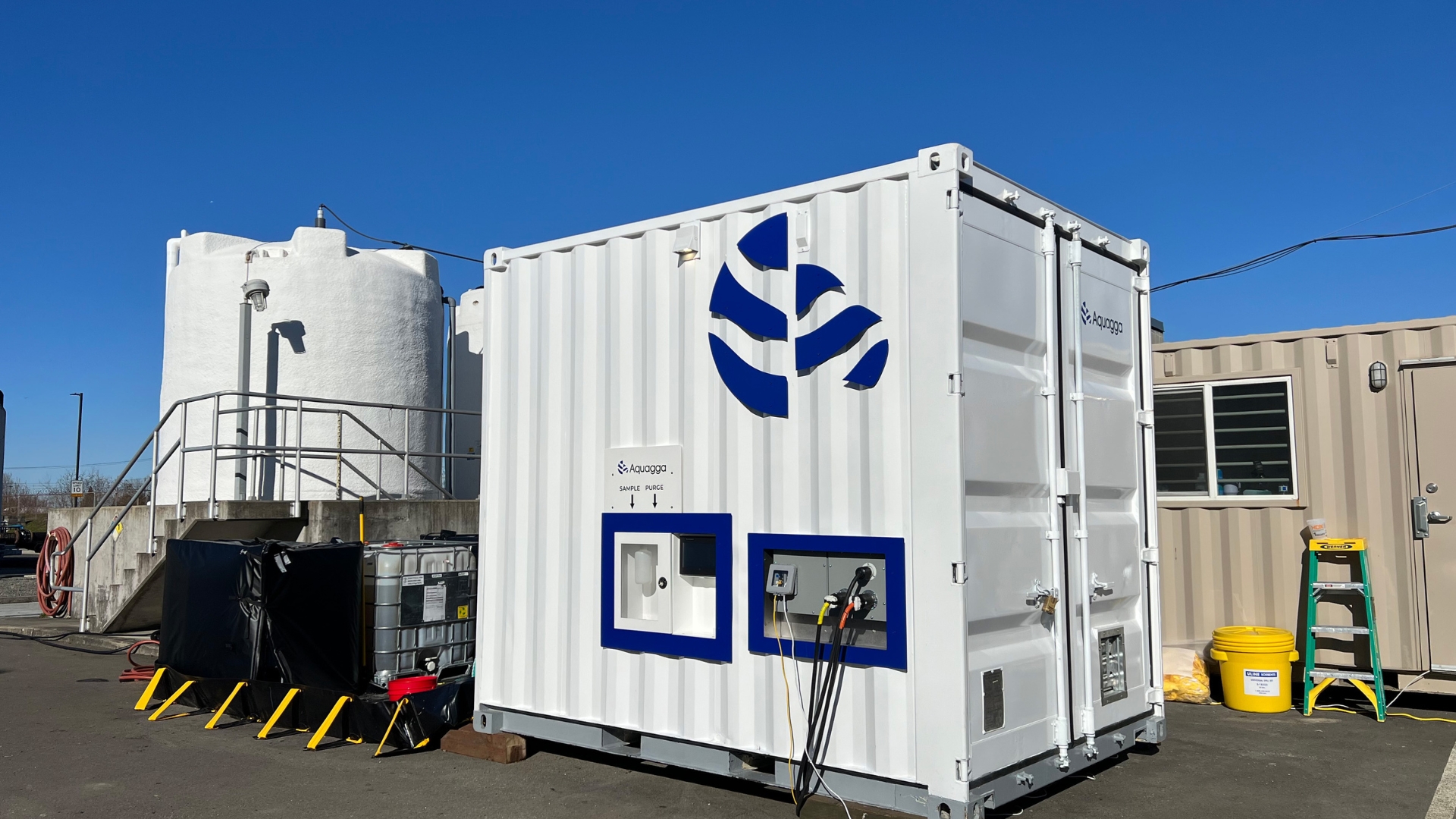Aquagga’s Mission to Eliminate “Forever Chemicals”
What if the solution to one of the planet’s most persistent and dangerous pollution challenges came not from a massive corporation, from but from a local PNW startup that has grown to become one of the world’s most promising innovators in environmental technology?
Meet Aquagga, a dual-use environmental tech company that’s on a mission to obliterate PFAS, the so-called ‘forever chemicals’ plaguing communities and military installations alike. In this Q & A, NW Tech Bridge catches up with Aquagga Co-Founder Chris Woodruff to talk origin story, entrepreneurial grit, and how public-private partnerships are accelerating real-world impact. From early days at the University of Washington to tackling Department of Defense challenges head-on, Chris shares how Aquagga is scaling breakthrough innovation to clean up the past, and protect our future.
With strong roots in the Pacific Northwest, deep ties to federal innovation programs, and a growing presence in both commercial and defense markets, Aquagga is a shining example of how dual-use startups can make a meaningful impact. Chris shares insights on the company’s origin, its evolving mission, and how partnerships with organizations including NW Tech Bridge have accelerated its path to market.
Q: Can you share a little bit about the journey that led to the founding of Aquagga and your role in its inception?
Aquagga was born out of a shared passion for solving complex environmental challenges with innovative technology. The company’s founders originally set out looking to convert sewage sludge to energy. Extensive customer discovery completed through the NSF I-Corps program led us to pivot to tackling the problem of PFAS—“forever chemicals”—in contaminated water using similar technology.
I met co-founders Dr. Brian Pinkard (CTO) & Nigel Sharp (founding CEO) while completing my master’s degree at the University of Washington, and early traction allowed us to commit to Aquagga full time and start building a stellar team around us. We recently celebrated our 5 year anniversary, welcomed Dhileep Sivam as CEO to lead the next phase of growth, and have expanded to a team of 20 exceptional team members.
Q: What are PFAS, how do they enter the environment, and what effects do they have?
PFAS (per- and polyfluoroalkyl substances) are a class of synthetic chemicals used in a wide range of products—from firefighting foams and waterproof textiles to food packaging and semiconductors. Their chemical structure makes them incredibly durable, which is great for performance but a major problem for the environment. PFAS can enter soil and water through industrial discharges, military fire training areas, landfills, and wastewater treatment facilities. Because they don’t naturally break down, they accumulate in the environment and in our bodies, and have been linked to serious health effects, including cancer, immune suppression, and developmental issues.
Q: How has NW Tech Bridge has supported Aquagga in its journey to commercialization? How could this support be advantageous to tech startups?
NW Tech Bridge has supported Aquagga by opening doors within the defense innovation ecosystem. Their team helped us navigate the early stages of engagement with military stakeholders, including site visits and introductions to program offices managing PFAS-impacted sites. For startups, this type of support is invaluable—it can take years to break into defense markets without a trusted connector. Tech Bridge, along with other DoD innovation groups like AFWERX, Defense Innovation Unit (DIU), and National Security Innovation Network (NSIN), accelerates that process, creating pathways for dual-use technologies like ours to connect with DoD customers while continuing to grow in the commercial sector.
For startups, this type of support is invaluable–it can take years to break into defense markets without a trusted connector.
Q: What solutions or products does Aquagga offer? How can this technology be applied in dual-use settings?
Aquagga is commercializing Hydrothermal Alkaline Treatment (HALT), a patented PFAS destruction technology capable of fully mineralizing all PFAS compounds—including short-chain variants—in concentrated waste streams. Our systems are designed to treat firefighting foam (AFFF) waste, landfill leachate, and industrial wastewater.
With 700+ DoD installations impacted by historical AFFF use, and an additional 8,000+ non-DoD sites with confirmed or suspected PFAS contamination, there are clear dual-use needs for destruction and disposal of PFAS at military installations and in commercial applications like hazardous waste facilities, semiconductor manufacturing, and chemical production. The ability to destroy PFAS on-site offers significant cost & operational advantages over traditional disposal methods like incineration or deep-well injection.
Q: What markets does Aquagga service?
We currently serve three primary markets:
- Defense and federal remediation, including PFAS-impacted sites at military bases, airports, and fire training facilities
- Solid waste, such as landfills and wastewater treatment plants managing leachate
- Industrial and manufacturing, including sectors like semiconductors and fluorochemical production
As regulations tighten and PFAS liabilities grow, we’re seeing increased demand across all three segments.
Q: Have you had success with securing SBIR grants?
Yes–we’ve been incredibly successful with the SBIR program, receiving awards from the EPA, NSF, USAF, DARPA, and Navy in addition to other non-dilutive funding. These grants have been pivotal in helping us advance our technology from the lab to pilot scale, moving from TRL-3 to TRL-7/8 over the past few years. Non-dilutive funding has been pivotal in helping de-risk our technology for dual-use applications and validate its effectiveness in real-world applications at customer sites through pilot demonstrations.
Q: Do you have any advice for companies interested in SBIR funding?
Start early and talk to your end-users. One of the biggest mistakes we see is treating SBIRs as pure R&D projects without aligning them to a real market need. The most successful applications demonstrate a clear customer pull and a commercialization pathway. Also, take advantage of the support available through universities, small business offices, and startup communities—they can help you avoid common pitfalls and put together successful proposals.
One of the biggest mistakes we see is treating SBIRs as pure R&D projects without aligning them to a real market need.
Q: Aquagga was recently selected to participate in a Defense Innovation Unit (DIU) project focused on PFAS destruction. What are the key objectives of this project?
We’re thrilled to be involved in this project—a groundbreaking initiative led by the DoD Environmental Security Technology Certification Program (ESTCP) in collaboration with the Defense Innovation Unit (DIU), the U.S. Air Force, and the U.S. Navy. This effort aims to advance the remediation of PFAS (per- and polyfluoroalkyl substances) at U.S. defense installations. The primary objectives of this project include:
- Identify efficient remediation strategies: Determining the most efficient and effective ways to remove and destroy PFAS in water, groundwater, soil, and sludge.
- Demonstrate effective PFAS removal & destruction: Evaluating emerging technologies capable of absorbing and/or destroying PFAS on-site or at centralized facilities.
- Standardize analytical methods: Utilize standardized methods for analyzing and sampling impacted soil and water to ensure objective evaluation of cost and performance among various vendors and prototype technologies.
In this initiative, Aquagga joins a cohort of ten companies demonstrating PFAS treatment technologies. Specifically, Aquagga, along with Arcadis, in conjunction with 374Water, Battelle, and General Atomics, will demonstrate PFAS destruction technologies.
A unique aspect of this project is the side-by-side comparison of different technologies at scale, providing an unprecedented opportunity to evaluate their effectiveness and cost-efficiency. Successful demonstrations will result in a “Success Memo,” enabling government buyers to procure follow-on production contracts without additional competitive procedures. Ultimately, this project is about scaling an innovative solution to meet the DoD’s urgent need for PFAS destruction—safely, effectively, and on-site.
A model for mission-aligned innovation
Aquagga’s journey reflects the power of mission-driven innovation, strategic partnerships, and relentless problem-solving in addressing some of today’s most urgent environmental challenges.
With the support of NW Tech Bridge and other key defense and commercial partners, the company is not only developing cutting-edge solutions to destroy PFAS, but also shaping a path for other dual-use startups to follow. As Aquagga continues to scale its impact, its story serves as a compelling example of how science, entrepreneurship, and public-private collaboration can come together to drive meaningful change—for both national security and global health.
Learn more about Aquagga at: https://www.aquagga.com/

Aquagga Leadership Team (left to right) Chris Woodruff Co-Founder & COO, Dhileep Sivam CEO, Dr. Brian Pinkard Co-Founder & CTO.

